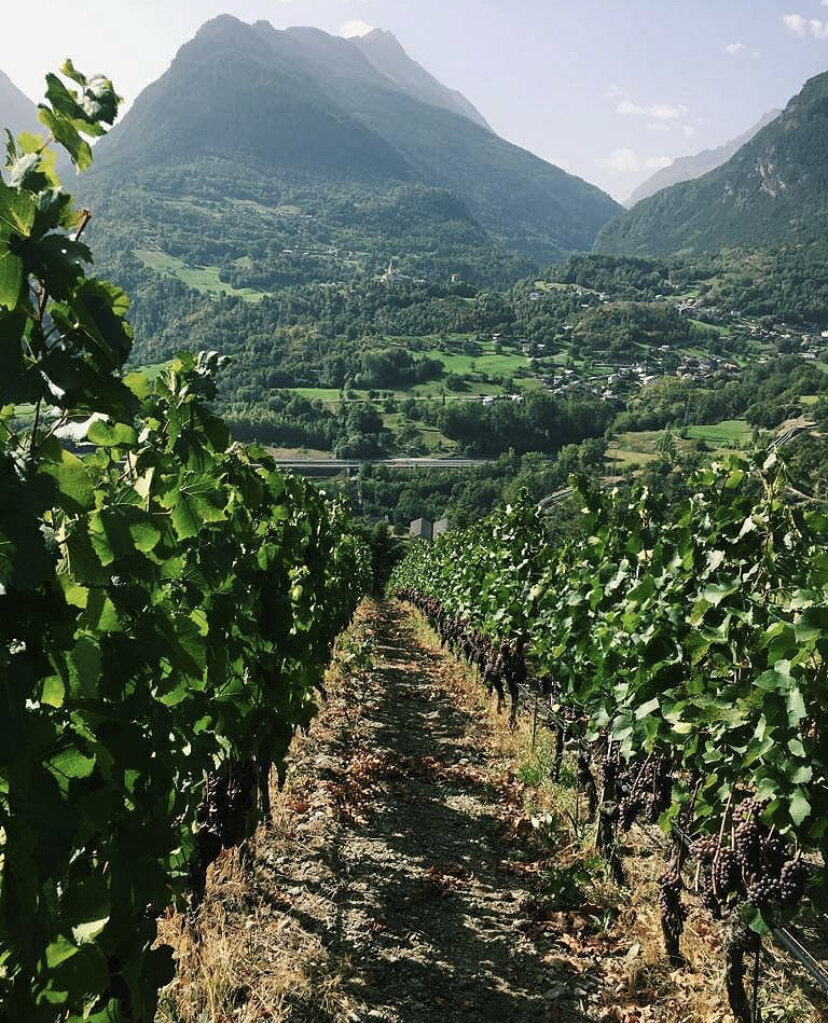Lo Triolet - Aosta, Italy
Marco Martin opening the goods.
LO TRIOLET AND THE WINES OF MARCO MARTIN
Our first voyage to Italy's wine hinterland of shoe-horned Valle D'Aoste (we are using the Lo Triolet local spelling vs. Aosta), almost as far north and west as you can go and still be in Italy, was about fifteen years ago. There were some wonderful wines, though then, trying to sell them was a singular work. We tried and we had some success. A few years later we were able to work through the typical national distribution network and were able find a few fine producer's wines, including the wines of Lo Triolet, Anselmet and Les Cretes, among others. The wines had an esoteric nature and were, on balance, expensive. In our now several trips to Valle D'Aoste we can say, with authority, that there is a "disconnect" between the place, people, wine community and the prices of their wines locally. Some Valle D'Aosta grapes have strange names, and wines made of Fumin, Prie Blanc, Cornalin and Petit Rouge scares away all but the most adventurous drinkers. As we all know, you cannot judge a book by its cover or a grape by its name, and of course a rose by any other name would smell as sweet. Along with the strange and cult-like grape names, there is the work. The vineyards are all on rugged slopes at high altitude and even driving a car there is dangerous, let alone trying to farm and harvest grapes. Lastly, they cannot grow vast amounts of grapes even if they wanted to, so the cult/danger/quantity trio added up to expensive wine(s). And in general, there is truth and logic to the rationale that these wines should be a little more expensive.
Other factors made us begin to question just HOW EXPENSIVE they ought to be. For example, consumers around the globe are not crying out for Fumin. No one in Australia is pulling out their Shiraz vines to plant plant Fumin, just as no one in our own Willamette Valley is replanting with Prie Blanc. Aosta is not a wealthy place: land, while scarce, does not require three mortgages and a lotto win. Aostan's are not shelling out $45 for a bottle of local Chardonnay and Aosta wines throughout the region are quite affordable in most restaurants. As we looked further, we could also see that prices at wineries in Aosta, while not dirt cheap, were disproportionately low there compared to what we were seeing in Oregon.
A while back we spent an afternoon with Marco Martin at his little winery in the village of Introd. We tasted through all his wines, sat and chatted, asked questions (we had many as we have been selling his wines for a number years, albeit intermittently) and formed a nice friendship with him. Although we said nothing, it was clear to us that the route his wines took to Oregon had some fiscal question marks based on what we see and know for wineries exporting throughout Europe to the USA and to Oregon. These question marks contained the rationale as to how winery A in Aosta has a Chardonnay that wold retail in Oregon for around $65 vs less than half that in its home land. We knew Marco was neither charging nor making that much. We held no grudge against any business attempting to make a profit. At some point, economic fairness will come home to roost if all parties seek what is best for their products. A few months ago, we were not surprised to learn that Marco had left his long time Importer, we felt like we did not need to ask why, but also felt our support and friendship opened a door for us and he to walk through together. Via E&R's ADI program (almost direct imports), we have been able to secure his wines directly to Oregon with a partner of ours.This has accommodated two important results; 1- the wines are considerably less expensive, and 2- supply is both now assured each year, and the vintages will always be the most current.
LO TRIOLET: THE WILD AND WONDROUS FUMIN
Val D'Aosta, wine-wise, is like a broken half parenthesis at an end of a forgotten sentence no one cared about to begin with. The grapes are weird: Petite Arvine, Blanc de Morgex, Cornalin, Fumin; that kind of thing. The farming is not easy and Napa-pretty, it can't be manicured and allowed to be bloated with tons and tons of grapes, you can't run tractors through the vines and pick up grapes with whirling husks of metal; in other words, you can't make any "real" money there. Wines, the best ones, are made with and through passion by small growers. It is quite possibly the only region in Italy where some reasonable portion of the wine production is NOT beholden to investors and the wealthy. (not saying that such things are bad, but quality here, per capita is of an altogether different ilk. We think you will see this even more in 2012 when we introduce three brand new Aostan producers to Oregon.)
So... Fumin??? The entire entry from the world's foremost guide and leading authority to wine grapes, Jancis Robinson's "Guide To Wine Grapes": 'Fumin, tough Valle D'Aosta specialty that is usually blended'. So, when does a great wine become great? Even the leading global expert on grapes has virtually no insight...
What a great leaning experience it was- my winery visit and overnight stay at Lo Triolet's Agriturismo this June- We'd wanted to visit Marco Martin for years. We tasted and talked through fifteen of his Lo Triolet ("trifoglio" is Italian patois for three leaf clover) wines where each was genuine and finely crafted, and did love them all. Among many special wines his Fumin was the wine of that afternoon. It was wild and ridiculous, as awkwardly, we had already used up every conceivable compliment before tasting it. Thus slowly taking in the wine - this only his second vintage as a 100% Fumin grape bottling - swirling the dark juice (btw, if you've wondered about revelation; that is, can you taste it... well yes, you can) - well Marco, he's like this experienced poker player; well Marco knew the hand he held in that bottle and he's watching me with just that tiniest edge of expression in his eyes (not his face), so I swirled some more and looked downward at the table while taking in stone and chocolate and dark, dense black fruit-immersed flavors, a kind of hyperion all to those satyrs - those over-oaked magazine cover Italian reds - Shakespeare-like, and in looking for the words to say about what was tasted, which was that Marco's Fumin was undeniably a great wine, well... whew, instead of spitting, the norm for wine tastings like this one which already followed two earlier winery visits that day: we swallowed the wine - and- like in a badly directed film, our eyes met, and what was said..... nothing - only just exchanged smiles.
(E)
Click on each wine for more detail.




